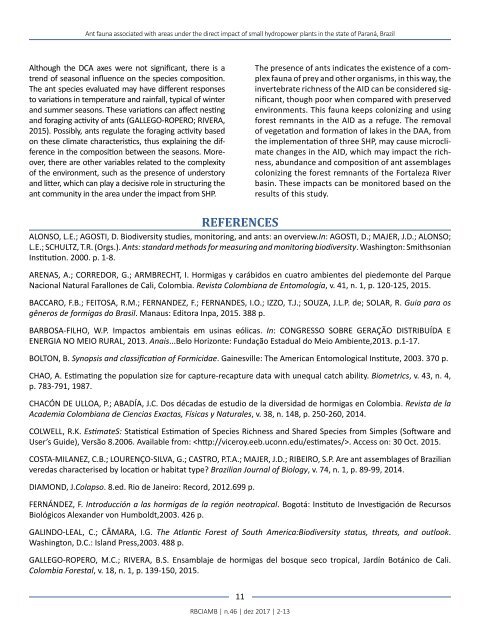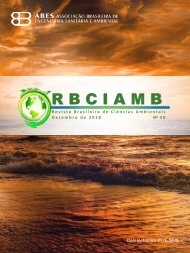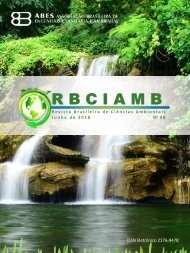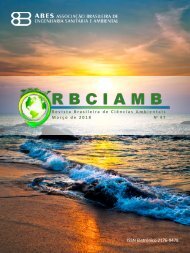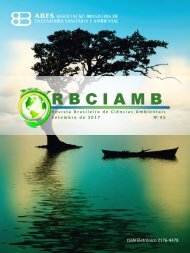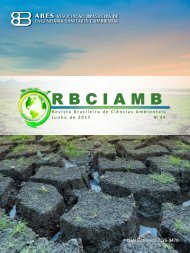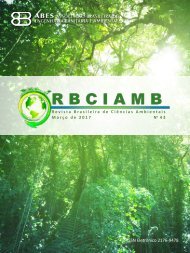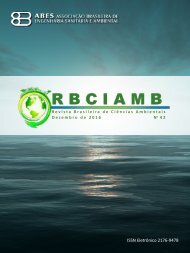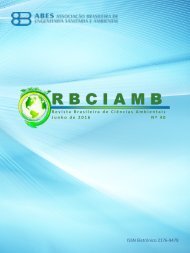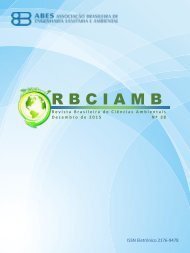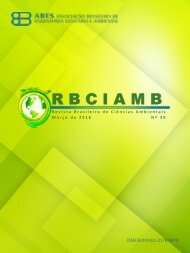Edição 46 RBCIAMB
Create successful ePaper yourself
Turn your PDF publications into a flip-book with our unique Google optimized e-Paper software.
Ant fauna associated with areas under the direct impact of small hydropower plants in the state of Paraná, Brazil<br />
Although the DCA axes were not significant, there is a<br />
trend of seasonal influence on the species composition.<br />
The ant species evaluated may have different responses<br />
to variations in temperature and rainfall, typical of winter<br />
and summer seasons. These variations can affect nesting<br />
and foraging activity of ants (GALLEGO-ROPERO; RIVERA,<br />
2015). Possibly, ants regulate the foraging activity based<br />
on these climate characteristics, thus explaining the difference<br />
in the composition between the seasons. Moreover,<br />
there are other variables related to the complexity<br />
of the environment, such as the presence of understory<br />
and litter, which can play a decisive role in structuring the<br />
ant community in the area under the impact from SHP.<br />
The presence of ants indicates the existence of a complex<br />
fauna of prey and other organisms, in this way, the<br />
invertebrate richness of the AID can be considered significant,<br />
though poor when compared with preserved<br />
environments. This fauna keeps colonizing and using<br />
forest remnants in the AID as a refuge. The removal<br />
of vegetation and formation of lakes in the DAA, from<br />
the implementation of three SHP, may cause microclimate<br />
changes in the AID, which may impact the richness,<br />
abundance and composition of ant assemblages<br />
colonizing the forest remnants of the Fortaleza River<br />
basin. These impacts can be monitored based on the<br />
results of this study.<br />
REFERENCES<br />
ALONSO, L.E.; AGOSTI, D. Biodiversity studies, monitoring, and ants: an overview.In: AGOSTI, D.; MAJER, J.D.; ALONSO;<br />
L.E.; SCHULTZ, T.R. (Orgs.). Ants: standard methods for measuring and monitoring biodiversity. Washington: Smithsonian<br />
Institution. 2000. p. 1-8.<br />
ARENAS, A.; CORREDOR, G.; ARMBRECHT, I. Hormigas y carábidos en cuatro ambientes del piedemonte del Parque<br />
Nacional Natural Farallones de Cali, Colombia. Revista Colombiana de Entomología, v. 41, n. 1, p. 120-125, 2015.<br />
BACCARO, F.B.; FEITOSA, R.M.; FERNANDEZ, F.; FERNANDES, I.O.; IZZO, T.J.; SOUZA, J.L.P. de; SOLAR, R. Guia para os<br />
gêneros de formigas do Brasil. Manaus: Editora Inpa, 2015. 388 p.<br />
BARBOSA-FILHO, W.P. Impactos ambientais em usinas eólicas. In: CONGRESSO SOBRE GERAÇÃO DISTRIBUÍDA E<br />
ENERGIA NO MEIO RURAL, 2013. Anais...Belo Horizonte: Fundação Estadual do Meio Ambiente,2013. p.1-17.<br />
BOLTON, B. Synopsis and classification of Formicidae. Gainesville: The American Entomological Institute, 2003. 370 p.<br />
CHAO, A. Estimating the population size for capture-recapture data with unequal catch ability. Biometrics, v. 43, n. 4,<br />
p. 783-791, 1987.<br />
CHACÓN DE ULLOA, P.; ABADÍA, J.C. Dos décadas de estudio de la diversidad de hormigas en Colombia. Revista de la<br />
Academia Colombiana de Ciencias Exactas, Físicas y Naturales, v. 38, n. 148, p. 250-260, 2014.<br />
COLWELL, R.K. EstimateS: Statistical Estimation of Species Richness and Shared Species from Simples (Software and<br />
User’s Guide), Versão 8.2006. Available from: . Access on: 30 Oct. 2015.<br />
COSTA-MILANEZ, C.B.; LOURENÇO-SILVA, G.; CASTRO, P.T.A.; MAJER, J.D.; RIBEIRO, S.P. Are ant assemblages of Brazilian<br />
veredas characterised by location or habitat type? Brazilian Journal of Biology, v. 74, n. 1, p. 89-99, 2014.<br />
DIAMOND, J.Colapso. 8.ed. Rio de Janeiro: Record, 2012.699 p.<br />
FERNÁNDEZ, F. Introducción a las hormigas de la región neotropical. Bogotá: Instituto de Investigación de Recursos<br />
Biológicos Alexander von Humboldt,2003. 426 p.<br />
GALINDO-LEAL, C.; CÂMARA, I.G. The Atlantic Forest of South America:Biodiversity status, threats, and outlook.<br />
Washington, D.C.: Island Press,2003. 488 p.<br />
GALLEGO-ROPERO, M.C.; RIVERA, B.S. Ensamblaje de hormigas del bosque seco tropical, Jardín Botánico de Cali.<br />
Colombia Forestal, v. 18, n. 1, p. 139-150, 2015.<br />
11<br />
<strong>RBCIAMB</strong> | n.<strong>46</strong> | dez 2017 | 2-13


